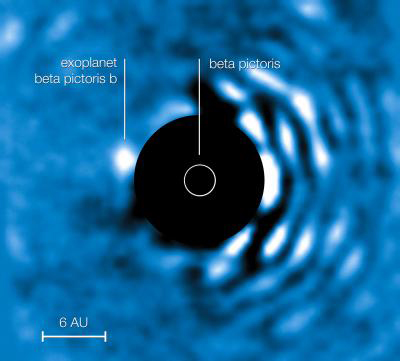Nearly 500 exoplanets – planets orbiting other stars – have been detected since the first was discovered in the mid-90s. A variety of methods have been used to find them: Doppler shift of starlight as the circling planets tug their stars, the dip in light as a planet passes directly in front of its star, even the change in light of a distant star as the gravity of a planet briefly magnifies it a la Einstein.
But getting direct pictures of planets is really hard. A typical star is roughly a billion times brighter than a planet! And from our great distance, the planet and star are so close together that the former is lost in the latter’s glare.
 But a new breakthrough has just been announced by astronomers at the University of Arizona – known for their ability to push the frontiers of what’s possible observationally. What they’ve done is complex, but basically, it reduces the glare from a star, allowing the fainter planet to be more easily detected.
But a new breakthrough has just been announced by astronomers at the University of Arizona – known for their ability to push the frontiers of what’s possible observationally. What they’ve done is complex, but basically, it reduces the glare from a star, allowing the fainter planet to be more easily detected.
The image here shows just such a detection! The planet orbiting the star Beta Pictoris has been known for some time, so it was a good choice to test the new optical design. They knew what they were looking for, and they found it! In the image, the location of Beta Pic is indicated. The ripples around it are diffraction patterns, a bit like ripples in a pond when you drop a rock in it (though more closely related to the ripples you see when water flows around an obstacle in its path like a rock or sandbar).
Any time you observe a star, what you get is a bright core, and a pattern of ripples like that; it’s built into the physics of light being a wave. What the new technique does is steal a bit of light from the core and use it to suppress some of those ripples. It interferes with them, damping them down. It only works on half the image, as you can see: on the right the ripples are obvious, and on the left they are essentially gone. If you’re looking for a planet, it means you have to observe it several times rotating the detector so you can clean up the halo all the way around the star.
I’m very, very impressed with this advance. Detecting planets directly in images is extremely hard; I’ve tried to do it myself with Hubble and it was a monumental pain in the derriere. That’s why we only have a handful of planets directly seen! The planet Beta Pic b is only about 6 times the distance from its star as Earth is from the Sun, so this new technique really allows astronomers to get in close.
I expect that over the next few years we’ll be seeing this technique used to see lots of previously detected planets and confirm their existence, as well as new planets around other stars. Way back when I worked on Hubble, I tried to determine if we could use our camera to spot a Jupiter-sized planet orbiting Alpha Centauri if it had the same separation from its star as Jupiter does from the Sun (about 800 million kilometers). We were really close, but in reality it would’ve been a nearly impossible task.
I suspect this new technique may make it a whole lot easier. So stay tuned. We may be getting a lot more pictures of faint new worlds very soon!
Image credit: ESO. Tip o’ the apodizing phase plate to Fark
Related posts:
- Theoretically, Alpha Centauri should have planets
- Another direct picture of a planet
- Another exoplanet imaged?
- First exoplanet imaged